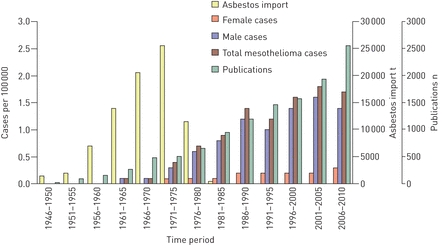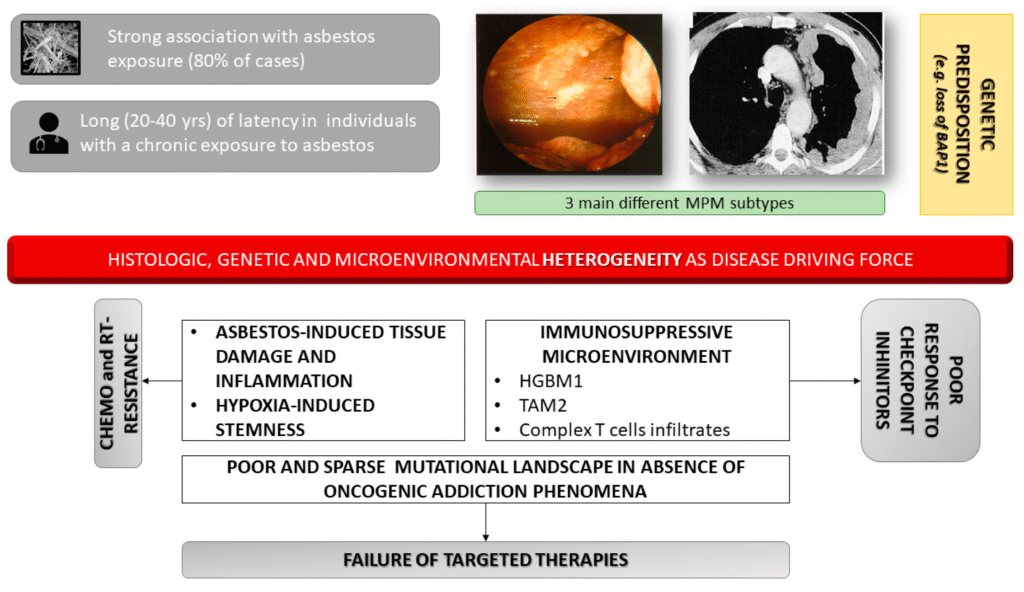Malignant Pleural Mesothelioma: Malignant pleural mesothelioma (MPM) is one of the most aggressive and deadly forms of cancer known today, and its root cause lies in a group of naturally occurring minerals known as asbestos. While the use of asbestos dates back thousands of years, it wasn’t until the 20th century industrial boom that large-scale mining and use began, ultimately leading to a global health crisis. The definitive link between asbestos and mesothelioma was established in 1960, marking a pivotal moment in medical and occupational health history.
Despite decades of growing awareness, malignant pleural mesothelioma continues to rise in incidence across the globe. The disease is highly resistant to traditional treatments such as chemotherapy and radiation, often diagnosed at advanced stages with a median survival of just 12 months. This grim prognosis has spurred international research efforts to improve early diagnosis, uncover novel treatments, and ban asbestos use worldwide.
In this comprehensive article, we explore the origin, progression, and ongoing controversy surrounding mesothelioma. We delve into historical contexts, examine modern epidemiological data, highlight emerging biomarkers, and consider the alarming risks posed by new materials like carbon nanofibres. Additionally, we discuss radiation and viral co-carcinogens, the biology of pleural tissues, and the pressing need for regulatory oversight to prevent future industrial epidemics.
The History of Asbestos and Mesothelioma
Ancient Use of Asbestos
The use of asbestos stretches back to ancient civilizations. Greeks, Finns, Norwegians, and Chinese all utilized the material for its unique properties — heat resistance, strength, and flexibility. It was even used to weave fire-cleaned napkins in Roman times. However, its use remained minimal until the industrial revolution.
Industrial Boom and Asbestos Proliferation
During the 20th century, asbestos was used extensively in insulation, shipbuilding, construction materials, automobile brakes, and even consumer products like toys and cigarette filters. At its peak, over 3,000 products incorporated asbestos, leading to widespread environmental and occupational exposure.
Medical Discovery and Link to Mesothelioma
Asbestos Categories
Asbestos minerals fall into two main families:
- Serpentine (Chrysotile): Short, curly white fibers; accounts for 95% of commercial use.
- Amphiboles (e.g., Crocidolite, Amosite): Straight, sharp fibers; more persistent in the lungs.
Stanton Fibre Hypothesis and Contamination Theory
Earlier theories suggested only amphiboles were dangerous, but subsequent research disproved this, showing that chrysotile also poses significant cancer risks, even without amphibole contamination. All asbestos types are now classified as Group I carcinogens by the WHO and IARC.
Also read: Revolt RV BlazeX: A New Commuter Electric Motorcycle Launched at Rs. 1.14 Lakh
Asbestos Exposure and Global Epidemiology
Occupational and Environmental Risk
Historically, mesothelioma cases were most prevalent among male workers in construction, mining, and shipbuilding. However, secondary exposure among family members and environmental exposure (e.g., living near asbestos factories) also pose significant risks.
Global Burden and Mortality
- Annual Toll: Over 107,000 deaths worldwide from mesothelioma, asbestosis, and related lung cancers.
- Regions at Risk: Incidence is stabilizing in countries with early asbestos bans (e.g., Sweden, UK) but rising rapidly in nations like China, India, Russia, and Kazakhstan where asbestos use continues.
Case Studies
- Italy: 25–33% of mesothelioma cases lived near asbestos factories.
- Turkey and China: Natural asbestos-like minerals (erionite, tremolite) caused mesothelioma epidemics.
- Greece (Metsovo): Cultural use of tremolite-containing whitewash led to cases among women.
Ionising Radiation and Viral Hypotheses
Radiation-Linked Mesothelioma
Radiation exposure, such as from Thorotrast or cancer treatments, is associated with mesothelioma, although it’s a rarer cause compared to asbestos.
Simian Virus 40 (SV40)
Contaminated polio vaccines in the 1950s–60s exposed millions to SV40, a virus known to cause mesothelioma in rodents. While human data is inconclusive, animal studies suggest SV40 may act as a co-carcinogen with asbestos.
Emerging Biomarkers and Genetic Susceptibility
Breakthroughs in Early Detection
Current research highlights several non-invasive biomarkers that show promise for early mesothelioma diagnosis:
- 13-Protein Signature: Predictive blood-based biomarker panel.
- MicroRNAs (miRNAs): Small RNA molecules linked to cancer development.
- BAP1 Syndrome: A genetic mutation (BRCA1-associated protein 1) that increases susceptibility to mesothelioma and other cancers.
These advances may revolutionize how mesothelioma is detected and treated, providing hope for earlier intervention and improved outcomes.

Pathophysiology and Pleural Fiber Clearance
Anatomy of the Pleura
The pleura consists of two layers:
- Parietal Pleura: Lines the chest wall and diaphragm.
- Visceral Pleura: Covers the lungs.
A thin film of fluid between them facilitates movement during breathing.
Fiber Inhalation and Mesothelioma Development
When asbestos fibers are inhaled, they bypass mucociliary clearance, lodge in the pleural space, and trigger chronic inflammation. Over time, this leads to DNA damage, cell proliferation, and ultimately, malignant transformation.
Modern Threats: Carbon Nanofibres and Other Manmade Materials
Carbon Nanofibres (CNFs)
Recent studies indicate that manmade nanomaterials — especially long, thin carbon nanofibres — may mimic asbestos in both structure and health risks. In in vitro and in vivo tests, these materials cause similar inflammation and cellular transformation seen with asbestos exposure.
Regulatory Concerns
Given the deadly history of asbestos, there is an urgent need for strict safety evaluations of new nanomaterials before widespread industrial use. Regulatory agencies must act to prevent another global health disaster.
Malignant Pleural Mesothelioma Conclusion
Malignant pleural mesothelioma stands as a haunting reminder of the consequences of unchecked industrial advancement. While much has been learned about its origins, mechanisms, and risks, the battle against mesothelioma is far from over. The disease continues to claim lives worldwide, especially in regions where asbestos is still in use or where environmental fibers remain unregulated.
Yet, there is hope. Advances in genetic research, early diagnostic biomarkers, and better public health policies offer a pathway forward. If the lessons of asbestos are heeded, and modern materials are thoroughly tested, the world can prevent future epidemics. As we look to the future, one message is clear: prevention is paramount — and history must not repeat itself.
Malignant Pleural Mesothelioma FAQs
1. What is malignant pleural mesothelioma?
Malignant pleural mesothelioma (MPM) is a rare and aggressive cancer that affects the pleura, the thin membrane surrounding the lungs. It is primarily caused by inhalation of asbestos fibers, which become embedded in the pleura and cause long-term inflammation, DNA damage, and eventually cancer.
2. How long does it take for mesothelioma to develop after asbestos exposure?
Mesothelioma typically has a long latency period. It can take 20 to 50 years after initial exposure to asbestos before symptoms begin to appear. This delayed onset makes early detection difficult and contributes to poor survival rates.
3. Is there a cure for mesothelioma?
Currently, there is no definitive cure for mesothelioma. Treatment options such as chemotherapy, radiation therapy, surgery, and immunotherapy may extend life expectancy and improve quality of life, but the prognosis remains poor. Median survival is about 12 months from diagnosis.
4. Can other materials besides asbestos cause mesothelioma?
Yes, other fibrous materials like erionite and carbon nanofibres have been linked to mesothelioma in specific environmental or experimental contexts. In addition, ionising radiation and simian virus 40 (SV40) have been proposed as potential co-carcinogens, though evidence in humans is still under investigation.


